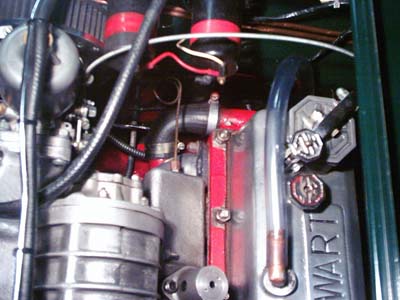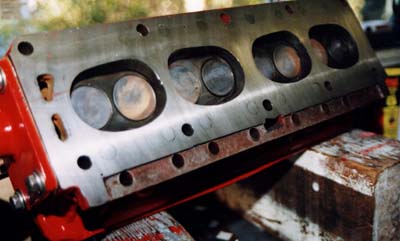
from above

from the side


The ‘end-to-end’ cooling system… as fitted to TC3306
As with the solving of most problems, it’s usually the last attempt that provides the answer – making you wonder why this method was not tried in the first place!
In my case the TC exhibited a worrying habit of showing coolant temperatures in the alarming sector of the gauge when driven ‘briskly’.This was made worse when used in competition in anything other than near freezing weather. The cooling system was examined and found to be perfect, numerous checks of mixture and timing of the magneto were made on the dyno. Grasping at straws. Even though supercharged the developed b.h.p. was considered to be well within the standard TC radiator’s ability to cope with the increase. Eventually we suspected the problem to be combustion gases entering the cooling system – confirmed by chemical analysis of the coolant. This problem is not unknown with modified late TD/XPEG engines running ‘round’ water passages, with precious little gasket between the bore and some waterways.
This is even more critical when the thing has been bunged-out to the limit! Stripping the top-end confirmed the blow-by ‘tracks’ between 3 cylinders and adjacent waterways on the side opposite the manifolds. Luckily no coolant was back-tracking into the bores – an advantage of a non-pressurised cooling system.
A special gasket from a ‘specialist’ was procured with water passages moved away from the bores as much as dared, giving a little more ‘meat’ in the critical areas. This came with assurances of success, quoting a number of other cures to those who had suffered the same problem. The rapid heating continued and another strip-down revealed failure of the expensive gasket in the same areas. The cylinder head and block deck faces were re-checked yet again and found to be still perfect.
By chance a friend unearthed his copy of the ‘MG Guide’ by Christy and Ludvigson, and pages 95 – 97 provided some hope. Further promise came after reading the text of James T. Crow’s Salon in ‘Road & Track’ Feb. 1977, the story of Ken Miles ‘R1’. A photograph showing the rear of the cylinder head of ‘R1’ on page 54 revealed the external plumbing linking the head to the rear side of the block. This arrangement was copied by Ken from the practice adopted by the MG factory-prepared engines used in record breaking attempts, in particular, Gardner’s EX/179.
‘MG Guide’ describes how the job can be done:
"First, all water passages in the mating surfaces of the head
and block must be closed off. This can be done either by using nickel
arc rod or, on engines numbered TD T/22735 and later, by drilling
and tapping each hole for a pipe thread plug. After insertion, each plug
is sawed off and ground flush with the surface."
(I deviated from this by use of a tapered tap and careful installation of the tapered BSP plugs, 1/8" and ¼", until just below the surface of the block deck – checked with an engineer’s steel rule. Each plug was sealed with a smear of Stag jointing compound. The head work was consigned to a trusted engine reconditioner for the additional insurance of a crack-test. The sealing of the head was done using tapered cast-iron plugs which were finished with instructions to take the lightest possible skim to finish off.
I intended using a head gasket – custom made without the circular water holes, the two rear elongated holes were retained in both head, block and of course gasket, just to make sure of a good transfer of coolant…a sort of ‘belt and braces’approach!).
The MG Guide continued:
"The freeze (Welch) plug at the rear of the water gallery is then
removed and the INSIDE wall of the water gallery bored out to the dimensions
of the plug or a little less. The plug is reinserted and the plug at the
back of the block removed. In place of this plug is set an outlet pipe
and a similar pipe is placed in the plate at the rear of the head. After
the head is installed, the two are connected with flexible radiator hose,
and the job is complete.
The above was a bit scary, made more so as the job was being performed with the engine in-situ. Judiciously, the well-known existing small hole at the bottom of the gallery was opened up with drill bits of increasing size, finished with a de-burring tool and die-grinder. Not a job for the feint-hearted or wimps, for you get a very good ‘coolant’s-eye-look’ at the wall of number 4 cylinder! The MG Guide’s description then covers mate-lapping head/block to run minus gasket, but as stated above, I used a special head gasket to save this laborious work and to maintain the compression ratio. See photo of gasket.
Ten years earlier I had received a very special birthday present from my wife. (She’s one very special lady!) Somehow she managed to acquire the actual Marshall supercharger that was used when TC 3306 ran in its original guise as an aluminium bodied monoposto racing car – quite well-known throughout the 1950’s in Australia as ‘The Red Cigar.’ There are photos in The Gallery. Among the treasure trove were all the manifolds, nose-drive, supporting brackets, linkages, oil metering and pipes… as well as a couple of interesting plates, both fitted with 90 degree water elbows.
One fitted the rear of the head… the other, diamond-shaped, had two 5/16" mounting holes at each end in the horizontal plane. This was made from ¼" plate and had the 1" dia O.D. thick-walled tube protruding 1/16" through the gasket face. Wired to this item was a 1/8" thick square-section copper washer the same O/D as the removed Welch plug. The 1/16" protrusion on the plate was provided to bite into this thick copper washer. A sort of cupreous ‘O’ ring. (Obviously the end-to-end arrangement of the cooling system had been used on this car sometime in its illustrious past. Just as obvious was that this must have been on a different block to that being currently ‘attacked’).
By carefully positioning the ¼" plate over the plug hole, noting the angle required to line-up with the pipe at the rear of the cylinder head, the two holes were carefully drilled and tapped to accept the mounting studs. Some casting ‘flash’ was carefully dressed away from each side of the Welch plug hole ensuring a square fit of the plate, with the copper ‘O-Ring’ smeared with Stag for a water-tight joint sandwiched in the plug hole. A water hose with a right-angle bend in the middle, with suitable I.D. to the outlet/inlet pipes to connect block to head was sourced from a local spare parts shop. Of all things, I recall this being labelled to fit a Toyota Camry.
In use the car now has not exceeded 185 degrees F., even at full throttle competing in historic race events, with the ambient temp in the high 20’s.
The demons (touch wood) seem to have been put to rest!